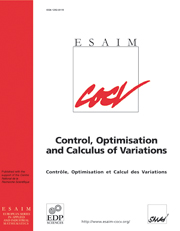No CrossRef data available.
Article contents
Well-posedness for Systems Representing Electromagnetic/Acoustic Wavefront Interaction
Published online by Cambridge University Press: 15 August 2002
Abstract
In this paper we consider dispersive electromagnetic systems in dielectric materials in the presence of acoustic wavefronts. A theory for existence, uniqueness, and continuous dependence on data is presented for a general class of systems which include acoustic pressure-dependent Debye polarization models for dielectric materials.
- Type
- Research Article
- Information
- ESAIM: Control, Optimisation and Calculus of Variations , Volume 8: A tribute to JL Lions , 2002 , pp. 105 - 125
- Copyright
- © EDP Sciences, SMAI, 2002




